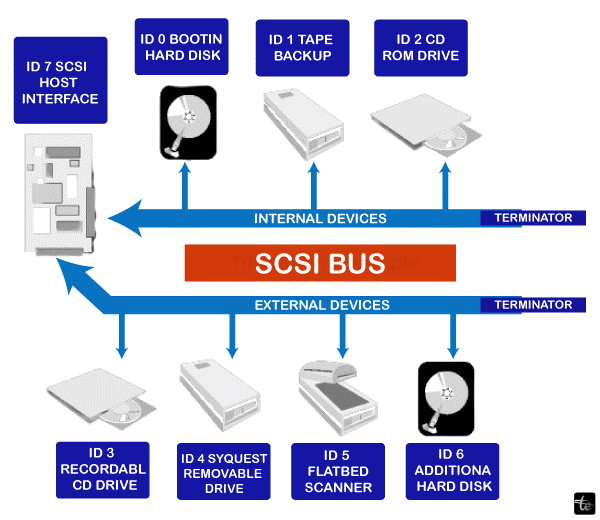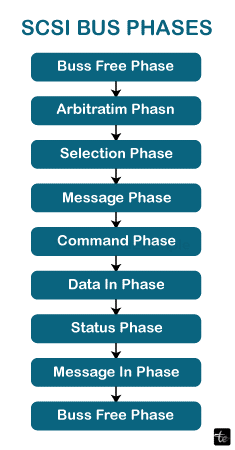SCSI Bus in Computer Architecture
Introduction
SCSI is a set of standards called Small Computer System Interface. It is primarily used with hard disc drives and other storage devices to physically connect and transfer data between computers and peripheral devices. Servers and high-end workstations have been using SCSI extensively since its inception in the 1980s. The SAS-4 SCSI specifications were introduced as recently as 2017.

The SCSI standards define commands such as protocols, electrical, optical, and logical interfaces. The SCSI standard specifies command sets for particular sorts of peripheral devices; as "unknown" is one of these types, it can theoretically be used as an interface to nearly any device; nonetheless, the standard is efficient and tailored to meet business needs. Although not all controllers can handle all devices, the original Parallel SCSI was mainly used for hard disc and tape drives. However, it can connect many other devices, such as CD drives and scanners.
Working of SCSI
To deploy SCSI on a system, you'll need SCSI adapters to interface with the system bus, the suitable SCSI devices (such as SCSI hard drives), SCSI cables to daisy-chain the devices, and SCSI terminators for the bus's ends. SCSI demands that every device on the bus have a distinct SCSI device ID number assigned to it to daisy-chain several machines on a single parallel bus. Dip switches, jumpers, configuration software, or both can be used to change the SCSI ID.
There are two main categories of SCSI devices:
- One-sided gadgets: To establish single-ended signal transmission across the bus, use one ground lead and one data lead. This equipment is less tolerant of cable lengths that exceed parameters and more susceptible to noise impacts.
- When using differential devices, ensure that both data leads are not at ground potential. Although these devices are typically more costly, they may frequently operate over distances above SCSI requirements and are immune to the effects of noise.
There are various types of SCSI interfaces available, such as the following:
- SCSI-1: The first SCSI standard, released in 1986, allows up to seven daisy-chained devices to transmit data at 5 Mbps over an 8-bit bus. Typically, Centronics 50 or Telco 50 connectors are used with SCSI-1 cables. The length of the chained bus cannot be more than 6 metres (20 feet).
- SCSI-2: Plain SCSI, this popular SCSI standard allows up to seven daisy-chained devices to share an 8-bit bus and transmit data at a maximum speed of 5 Mbps. Micro DB50 connectors are commonly used with SCSI-2 connections. While Fast Wide SCSI employs a 16-bit bus and enables 20 Mbps rates, Fast SCSI is a variation that supports 10 Mbps transfer rates.
- SCSI-3: Often referred to as Mega SCSI t, his SCSI protocol enables up to 15 daisy-chained peripherals to share an 8- or 16-bit bus at 20 to 40 Mbps in terms of transfer speed. SCSI-3 connections often feature connectors with Compact 68 or MicroSD 68 pins.
- SCSI-4: Also known as Very High-Density Connector Interface (VHDCI), this SCSI standard is comparable to SCSI-3 but uses a connector that is only 0.8 millimeters in size. High performance is a crucial requirement for next-generation SCSI connections, which is why SCSI-5 was created. It is the recommended connection for complex SCSI multiport applications such as Ultra SCSI Fast-20 and the newly released Low-Voltage Differential Signal (LVDS) technology.
SCSI Host Adapter
A component that connects a computer bus to one or more SCSI devices is called an SCSI host adapter. It is incorrect to refer to an SCSI host adapter as an SCSI controller since a controller is any component that can comprehend the SCSI protocol. In this idea, data transmission from the computer's input/output bus to the SCSI bus is handled by host adapters, while an SCSI controller is included in every SCSI device.
SCSI Devices
This category contains many peripheral devices, such as printers, scanners, CD/DVD drives, tape recording drives, and hard drives. These gadgets are intended to be attached to a SCSI machine and use the SCSI host appendage to interact with the host computer. A SCSI machine is the physical link between the SCSI host appendage and SCSI bias. Depending on the bias and computer arrangement, it might be internal or external.
Small Computer System Interface (SCSI) and Tools
While not every device can handle every SCSI level, SCSI standards are usually backwards compatible. In other words, an older peripheral device will function at a slower and older data rate when linked to a newer computer supporting a later standard. Universal Serial Bus (USB) has largely replaced the SCSI in personal computers. Hard disc controllers in server farms within the company still use SCSI.

SCSI Components
SCSI storage systems employ several components:
- Initiator: An initiator asks SCSI devices for assistance and gets back to them. Different initiators are available; they can be found inside the host bus adapter or built onto the server's system board. A software-based initiator is usually used for iSCSI communication.
- Target: Although software-based SCSI targets are also possible, the SCSI target is usually a physical storage device. A single hard drive or a whole storage array can be the target. Hardware not used for storage may also function as a SCSI target. It was commonplace to use an optical scanner as an SCSI target to link it to a computer via an SCSI bus.
- Service Delivery Subsystem: The cabling-based mechanism facilitates communication between the initiator and the target.
- Expander: Exclusive to SCSI (Serial Attached SCSI), it permits sharing a single initiator port among numerous SAS devices.
Serial-Attached SCSI
- Devices using older SCSI technologies can be used with SAS products. When SCSI performance is insufficient, the Serial Storage Architecture (SSA) standard can be utilized. One example is iSCSI, which embeds SCSI-3 over TCP/IP (most SCSI-3 specification designations start with Ultra). Keeps command settings intact.
- SAS is now a well-liked substitute for parallel SCSI in business settings. The SCSI command set is the foundation for both serial and parallel SCSI. Compared to SCSI, SAS Parallel has the following clear advantages:
- Up to 65,535 devices can be supported (with an extension). Recent parallel SCSI standards support no more than 16 devices.
- It is a point-to-point technology that solves the issues of termination and clock malfunction. As a result, SAS is unaffected by the resource contention problems that parallel SCSI frequently faces.
Applications of SCSI
- Data Storage: There is no denying SCSI's dominance in this field. It's widely used in enterprise-level storage systems, where quick access to and transmission of data is crucial. The technology is a top option for companies and organizations looking for high-performance data storage solutions because of its dependability and effectiveness.
- Servers: SCSI is a preferred interface in server environments due to its dependable and quick data transmission capabilities. Servers are the foundation of modern computing. SCSI technology contributes to the server's smooth operation by lowering latency, essential for quickly responding to user requests and improving overall system performance.
- External Devices: SCSI is the recommended interface for several external devices, such as hard drives, printers, and scanners. Thanks to the technology's adaptability and interoperability, these devices can be easily integrated into a computer system, which increases convenience and productivity.
Advantages of SCSI
- Speed: SCSI has a high data transfer rate and excellent performance. It is the recommended option when quick access to data is crucial.
- Scalability: SCSI allows devices to be daisy-chained together for small setups and large, scalable storage configurations.
SCSI implementation is not without its difficulties, though.
Disadvantages of SCSI
- Cost: Compared to alternative interfaces, SCSI gear and cabling might be more expensive; some users may find this a financial consideration.
- Complexity: SCSI setup and configuration can be complicated, requiring higher technical knowledge, which may put off some users.
SCSI has created a lasting impression by providing several benefits like scalability, speed, and dependability, making it a crucial component of many applications.
Conclusion
In summary, SCSI's legacy lives on as a dependable and practical interface that propels advancements in computer technology.